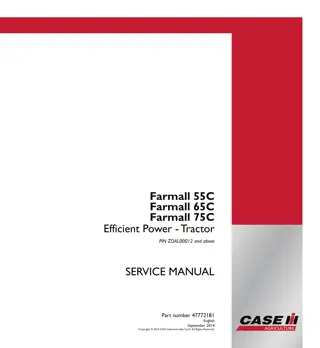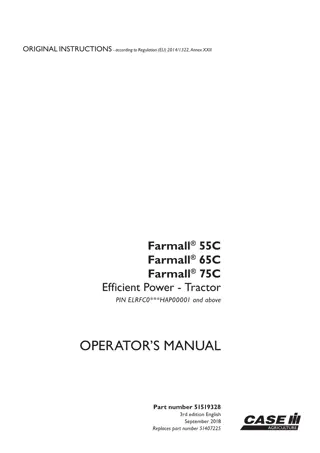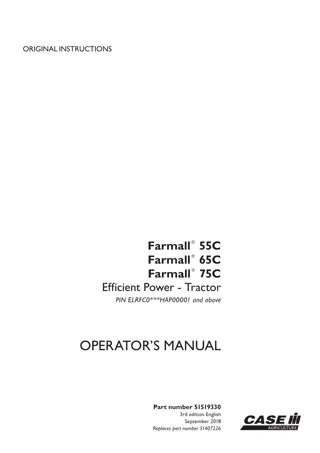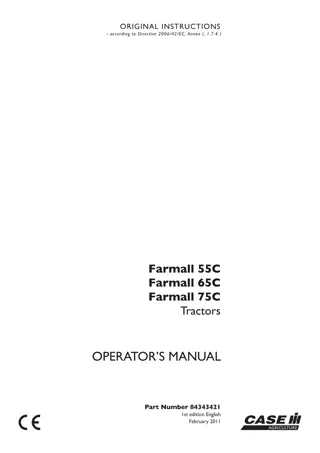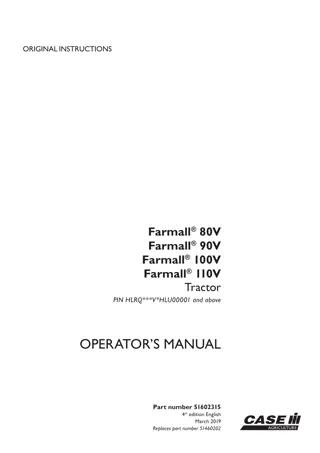
CASE IH Farmall 65C Efficient Power - Tractor Service Repair Manual Instant Download (PIN ZDAL00012 and above)
Please open the website below to get the complete manualnn//
Download Presentation

Please find below an Image/Link to download the presentation.
The content on the website is provided AS IS for your information and personal use only. It may not be sold, licensed, or shared on other websites without obtaining consent from the author. Download presentation by click this link. If you encounter any issues during the download, it is possible that the publisher has removed the file from their server.
E N D
Presentation Transcript
SERVICE MANUAL Farmall 55C Farmall 65C Farmall 75C Farmall 55C Farmall 65C Farmall 75C Efficient Power - Tractor Efficient Power - Tractor PIN ZDAL00012 and above Part number 47772181 1/4 SERVICE MANUAL Part number 47772181 English September 2014 Copyright 2014 CNH Industrial Italia S.p.A. All Rights Reserved.
Link Product / Engine Product Market Product Australia New Zealand Europe Asia Pacific Middle East Africa Middle East Africa Europe Asia Pacific Australia New Zealand Australia New Zealand Europe Asia Pacific Middle East Africa Middle East Africa Europe Asia Pacific Australia New Zealand Europe Engine Farmall 55C senza cabina Farmall 55C senza cabina Farmall 55C senza cabina Farmall 55C senza cabina Farmall 55C con cabina Farmall 55C con cabina Farmall 55C con cabina Farmall 55C con cabina Farmall 65C senza cabina Farmall 65C senza cabina Farmall 65C senza cabina Farmall 65C senza cabina Farmall 65C con cabina Farmall 65C con cabina Farmall 65C con cabina Farmall 65C con cabina Farmall 75C senza cabina [ZxALxxxxx] Farmall 75C senza cabina [ZxALxxxxx] Farmall 75C senza cabina [ZxALxxxxx] Farmall 75C senza cabina [ZxALxxxxx] Farmall 75C con cabina [ZxALxxxxx] Farmall 75C con cabina [ZxALxxxxx] Farmall 75C con cabina [ZxALxxxxx] Farmall 75C con cabina [ZxALxxxxx] F5DFL463C*F004 F5DFL463C*F004 F5DFL463C*F004 F5DFL463C*F004 F5DFL463C*F004 F5DFL463C*F004 F5DFL463C*F004 F5DFL463C*F004 F5DFL463B*F006 F5DFL463B*F006 F5DFL463B*F006 F5DFL463B*F006 F5DFL463B*F006 F5DFL463B*F006 F5DFL463B*F006 F5DFL463B*F006 F5DFL463A*F017 Australia New Zealand F5DFL463A*F017 Asia Pacific F5DFL463A*F017 Middle East Africa F5DFL463A*F017 Europe F5DFL463A*F017 Middle East Africa F5DFL463A*F017 Asia Pacific F5DFL463A*F017 Australia New Zealand F5DFL463A*F017 47772181 04/11/2014
Contents INTRODUCTION Engine....................................................................................... 10 [10.001] Engine and crankcase ............................................................. 10.1 [10.216] Fuel tanks .......................................................................... 10.2 [10.501] Exhaust Gas Recirculation (EGR) - Diesel Particulate Filter (DPF) exhaust treatment .................................................................................... 10.3 [10.414] Fan and drive ...................................................................... 10.4 Clutch ....................................................................................... 18 [18.100] Clutch mechanical release control ................................................. 18.1 [18.104] Clutch hydraulic release control.................................................... 18.2 [18.110] Clutch and components ............................................................ 18.3 Transmission.............................................................................. 21 [21.114] Mechanical transmission ........................................................... 21.1 [21.140] Mechanical transmission internal components..................................... 21.2 [21.112] Power shuttle transmission......................................................... 21.3 [21.134] Power shuttle transmission external controls ...................................... 21.4 [21.104] Power shuttle transmission lubrication system..................................... 21.5 [21.154] Power shuttle transmission internal components .................................. 21.6 [21.160] Creeper ............................................................................ 21.7 [21.162] Reverser ........................................................................... 21.8 [21.109] Transmission cooler and lines...................................................... 21.9 Four-Wheel Drive (4WD) system .................................................. 23 [23.202] Electro-hydraulic control ........................................................... 23.1 Front axle system ....................................................................... 25 [25.100] Powered front axle ................................................................. 25.1 [25.102] Front bevel gear set and differential ............................................... 25.2 [25.108] Final drive hub, steering knuckles, and shafts ..................................... 25.3 47772181 04/11/2014
https://www.ebooklibonline.com Hello dear friend! Thank you very much for reading. Enter the link into your browser. The full manual is available for immediate download. https://www.ebooklibonline.com
[25.400] Non-powered front axle ............................................................ 25.4 Rear axle system........................................................................ 27 [27.100] Powered rear axle.................................................................. 27.1 [27.106] Rear bevel gear set and differential................................................ 27.2 [27.120] Planetary and final drives .......................................................... 27.3 Power Take-Off (PTO)................................................................. 31 [31.101] Rear mechanical control ........................................................... 31.1 [31.104] Rear electro-hydraulic control...................................................... 31.2 [31.110] One-speed rear Power Take-Off (PTO) ............................................ 31.3 [31.114] Two-speed rear Power Take-Off (PTO) ............................................ 31.4 Brakes and controls .................................................................... 33 [33.202] Hydraulic service brakes ........................................................... 33.1 [33.110] Parking brake or parking lock ...................................................... 33.2 [33.220] Trailer brake hydraulic control...................................................... 33.3 Hydraulic systems....................................................................... 35 [35.104] Fixed displacement pump.......................................................... 35.1 [35.204] Remote control valves ............................................................. 35.2 [35.114] Three-point hitch control valve ..................................................... 35.3 [35.116] Three-point hitch cylinder .......................................................... 35.4 [35.701] Front loader arm hydraulic system................................................. 35.5 [35.723] Front loader bucket hydraulic system.............................................. 35.6 Hitches, drawbars, and implement couplings.................................. 37 [37.100] Drawbars and towing hitches ...................................................... 37.1 [37.110] Rear three-point hitch .............................................................. 37.2 Steering..................................................................................... 41 [41.106] Tie rods............................................................................. 41.1 [41.206] Pump............................................................................... 41.2 47772181 04/11/2014
[41.101] Steering control .................................................................... 41.3 [41.200] Hydraulic control components...................................................... 41.4 [41.216] Cylinders ........................................................................... 41.5 Wheels...................................................................................... 44 [44.511] Front wheels........................................................................ 44.1 [44.520] Rear wheels........................................................................ 44.2 Cab climate control..................................................................... 50 [50.100] Heating............................................................................. 50.1 [50.104] Ventilation .......................................................................... 50.2 [50.200] Air conditioning..................................................................... 50.3 Electrical systems....................................................................... 55 [55.100] Harnesses and connectors......................................................... 55.1 [55.201] Engine starting system............................................................. 55.2 [55.301] Alternator........................................................................... 55.3 [55.302] Battery.............................................................................. 55.4 [55.640] Electronic modules................................................................. 55.5 [55.048] Rear Power Take-Off (PTO) control system ....................................... 55.6 [55.408] Warning indicators, alarms, and instruments ...................................... 55.7 [55.DTC] FAULT CODES.................................................................... 55.8 Front loader and bucket............................................................... 82 [82.100] Arm................................................................................. 82.1 [82.300] Bucket.............................................................................. 82.2 [82.AAA] Front loader and bucket generic sub-group ....................................... 82.3 Platform, cab, bodywork, and decals............................................. 90 [90.150] Cab................................................................................. 90.1 [90.151] Cab interior......................................................................... 90.2 [90.160] Cab interior trim and panels........................................................ 90.3 [90.154] Cab doors and hatches ............................................................ 90.4 47772181 04/11/2014
[90.110] Operator platform less cab ......................................................... 90.5 [90.100] Engine hood and panels ........................................................... 90.6 47772181 04/11/2014
INTRODUCTION 47772181 04/11/2014 1
INTRODUCTION Note to the Owner WARNINGS FOR AIR CONDITIONING SYSTEM REPAIR OPERATIONS Starting the system at low temperatures can damage the compressor. Only operate the air conditioner when the engine is hot and the temperature inside the cab is at least 20 C (68.00 F). When disconnecting the hoses, close the ends with plastic caps to prevent foreign matter and humidity from getting inside the hoses. Handle the thermostatic sensor carefully to avoid damage that may prevent efficient system operation. Always use two spanners to unscrew the hose fittings to avoid twisting the fitting. Do not use any type of engine oil to lubricate the compressor and the system. Never leave the compressor oil container open, always make sure that it is tightly closed. If left exposed the oil will absorb humidity from the air and may, subsequently, damage the system. Do not transfer compressor oil from the original container to another container. Do not introduce any additives to the compressor oil. Any additional substances could contain elements which are incompatible with the chemical base of the refrigerant and thus alter its characteristics. Check that the thermostatic sensor is correctly inserted in the fins on the evaporator to ensure efficient system oper- ation. 47772181 04/11/2014 4
INTRODUCTION Safety rules SAFETY REGULATIONS TO PREVENT ACCIDENTS Most accidents or injuries that occur in workshops are the result of non--observance of simple and fundamental safety regulations. For this reason, IN MOST CASES THESE ACCIDENTS CAN BE AVOIDED: by foreseeing possible causes and con- sequently acting with the necessary caution and care. Accidents may occur with all types of vehicle, regardless of how well it was designed and built. A careful and judicious service technician is the best guarantee against accidents. Precise observance of the most basic safety rule is normally sufficient to avoid many serious accidents. DANGER: Never carry out any cleaning, lubrication or maintenance operations when the engine is running. GENERAL Carefully follow specified repair and maintenance procedures. Do not wear rings, wristwatches, jewellery, unbuttoned or loose articles of clothing such as: ties, torn clothing, scarves, open jackets or shirts with open zips that may remain entangled in moving parts. It is advised to wear approved safety clothing, e.g: non--slip footwear, gloves, safety goggles, helmets, etc. Do not carry out repair operations with someone sitting in the driver s seat, unless the person is a trained technician who is assisting with the operation in question. Operate the vehicle and use the implements exclusively from the driver s seat. Do not carry out operations on the vehicle with the engine running, unless specifically indicated. Stop the engine and ensure that all pressure is relieved from hydraulic circuits before removing caps, covers, valves, etc. All repair and maintenance operations must be carried out using extreme care and attention. Service steps and platforms used in a workshop or in the field should be built in compliance with the safety rules in force. Disconnect the batteries and label all controls to indicate that the vehicle is being serviced. Block the machine and all equipment which should be raised. Do not check or fill fuel tanks, accumulator batteries, nor use starting liquid when smoking or near naked flames, as these fluids are inflammable. Brakes are inoperative if manually released for repair or maintenance purposes. In such cases, the machine should be kept constantly under control using blocks or similar devices. The fuel nozzle should always be in contact with the filling aperture. Maintain this position until filling operations are completed in order to avoid possible sparks caused by the accumulation of static electricity. Only use specified towing points for towing the tractor, connect parts carefully.Make sure that all pins and/or locks are secured in position before applying traction. Never remain near the towing bars, cables or chains that are operating under load Transport vehicles that cannot be driven using a trailer or a low--loading platform trolley, if available. When loading or unloading the vehicle from the trailer (or other means of transport), select a flat area capable of sustaining the trailer or truck wheels, firmly secure the tractor to the truck or trailer and lock the wheels in the position. Electric heaters, battery--chargers and similar equipment must only be powered by auxiliary power supplies with efficient ground insulation to avoid electrical shock hazards. Always use suitable hoisting or lifting devices when raising or moving heavy parts. Take extra care if bystanders are present. Never pour gasoline or diesel oil into open, wide and low containers. Never use gasoline, diesel oil or other inflammable liquids as cleaning agents. Use non-flammable non-toxic pro- prietary solvents. Wear safety goggles with side guards when cleaning parts with compressed air. Limit the air pressure to a maximum of 2.1 bar (30.5 psi), according to local regulations. 47772181 04/11/2014 5
INTRODUCTION Do not run the engine in confined spaces without suitable ventilation. Do not smoke, use naked flames, or cause sparks in the area when fuel filling or handling highly inflammable liquids. Never use naked flames for lighting when working on the machine or checking for leaks. All movements must be carried out carefully when working under, on or near the vehicle and wear protective equip- ment: helmets, goggles and special footwear. When carrying out checks with the engine running, request the assistance of an operator in the driver s seat. The operator must maintain visual contact with the service technician at all times. If operating outside the workshop, position the vehicle on a flat surface and lock in position. If working on a slope, lock the vehicle in position and move to a flat area as soon as is safely possible. Damaged or bent chains or cables are unreliable. Do not use them for lifting or towing. Always use suitable protective gloves when handling chains or cables. Chains should always be safely secured. Ensure that fastening device is strong enough to hold the load foreseen. No persons should stop near the fastening point, trailing chains or cables. Maintenance and repair operations must be carried out in a CLEAN and DRY area, eliminate any water or oil spillage immediately. Do not create piles of oil or grease--soaked rags as they represent a serious fire hazard; store them in a closed metal container. Before starting the vehicle or implements, make sure that the driver s seat is locked in position and always check that the area is free of persons or obstacles. Empty pockets of all objects that may fall unobserved into the vehicle parts when disassembled. In the presence of protruding metal parts, use protective goggles or goggles with side guards, helmets, special footwear and gloves. Handle all parts carefully, do not put your hands or fingers between moving parts, wear suitable safety clothing -- safety goggles, gloves and shoes. WELDING OPERATIONS When welding, use protective safety devices: tinted safety goggles, helmets, special overalls, gloves and footwear. All persons present in the area where welding is taking place must wear tinted goggles. NEVER LOOK AT THE WELDING ARC IF YOUR EYES ARE NOT SUITABLY PROTECTED. Where possible, remove the part or tool that requires arc welding from the tractor. Disconnect both battery leads. Isolate the cable ends to avoid contact with each other and the tractor. Position the welder ground clamp as near as possible to the area where welding is taking place. Remove the electronic control units located on the tractor if welding is to be carried out near these control units. Never allow welding cables to lay on, near or across any electrical wiring or electronic component while welding is in progress. Metal cables tend to fray with repeated use. Always use suitable protective devices (gloves, goggles, etc.) when handling cables. START UP Never start the engine in confined spaces that are not equipped with adequate ventilation for exhaust gas extraction. Never place the head, body, limbs, feet, hands or fingers near fans or rotating belts. ENGINE Always loosen the radiator cap slowly before removing it to allow any remaining pressure in the system to be dis- charged. Coolant should be topped up only when the engine is stopped or idle if hot. Never fill up with fuel when the engine is running, especially if hot, in order to prevent the outbreak of fire as a result of fuel spillage Never check or adjust fan belt tension when the engine is running. Never adjust the fuel injection pump when the vehicle is moving. 47772181 04/11/2014 6
SERVICE MANUAL Engine Farmall 55C without cab, Farmall 55C with cab, Farmall 65C without cab, Farmall 65C with cab, Farmall 75C without cab [ZxALxxxxx], Farmall 75C with cab [ZxALxxxxx] 47772181 04/11/2014 10
Engine - Engine and crankcase Engine - Remove NOTE: For models with front-end loaders only, perform the following points before carrying out the instructions below: Remove the cab including the platform (see Cab - Re- move (90.150)) or just the platform (see Operator plat- form less cab - Remove (90.110)) Remove the mid mount valves (see Mid-mount remote control valve - Remove (35.204)) Loosen the retaining bolts (1) and (3). Remove the cab support or platform (4). Remove the front-end loader sup- port (2). 1 MOIL13TR02963AA NOTE: The following operations are valid for all versions. 1. Remove the hood, as described in Hood - Remove (90.100) . 2. Remove the battery, as described in Battery - Remove (55.302) . 3. Remove the fuel tank, as described in Fuel tank - Re- move (10.216) . 4. Loosen the retaining bolts (1). Remove the front wheel fenders (2), if any, from both sides. 2 WLAPL4S10C104A 5. Recover the refrigerant from the system via the fittings (1) and (2), using the special tool 380000315. Detach the two lines by disconnecting any support straps. 3 WLAPL4S10C106AA 47772181 04/11/2014 10.1 [10.001] / 3
Engine - Engine and crankcase 6. Disconnect and remove the lines from the cab air con- ditioning and heating (if any) (1) and (2). 4 MOIL13TR02884AA 7. Place a suitable container under the drain plug (1) for the gearbox-transmission oil. Loosen the plug. Drain the oil. 5 MOIL13TR00197AA 8. Detach the supply and return pipes for the transmission cooling oil at the connection point (1). Release the pipes from their anchorage on the engine block. 6 MOIL13TR02886AB 9. Raise the rear of the tractor with a hydraulic jack. Place a mechanical jack stand under the reduction gear case. Use a pneumatic gun to remove the retaining nuts of the left-hand rear wheel. Then remove the wheel. 7 WLAPL4S10C110A 47772181 04/11/2014 10.1 [10.001] / 4
Engine - Engine and crankcase 10. Remove the front, central, and rear retaining bolts on the guard of the front-wheel drive control shaft. Then remove the guard (1). 8 WLAPL4S10C112AA 11. Remove the snap ring (2) and move the front sleeve (1) in the direction indicated by the arrow in order to release it from the groove on the front axle. 9 WLAPL4S10C113AA 12. Remove the bolts that secure the central support (1) of the drive shaft. Remove the shaft complete with the support. Also remove the shim that adjusts the clearance of the shaft on the back. 10 WLAPL4S10C115AA 13. Loosen the straps. Detach the suction tube (1) to the oil filter from the transmission (2). 11 MOIL13TR02887AB 47772181 04/11/2014 10.1 [10.001] / 5
Engine - Engine and crankcase 14. For machines with a hydraulic lift and mid mount valves, disconnect the oil supply tube to the distributor of the lift and of the mid mount valves (1), if any, at the connection point (3). Remove the transmission oil filter (2). 12 MOIL13TR02888AB 15. Disconnect all of the electrical connections that prevent the detachment of the engine from the gear- box-transmission case, such as main connections (1), main cab connection and power (2), engine control unit connections (3), fuse compartment (4), sensors, and extensions according to the tractor model. 13 MOIL13TR02889AB 16. Loosen the retaining bolts (1). Remove the top radia- tor guard (2). Remove all of the remaining free wire harnesses. 14 MOIL13TR02942AA 17. Loosen the strap on the inlet of the tubing (1) that supplies water to the radiator. Disconnect the tube. Drain and recharge the engine coolant. 18. Loosen the retain strap. Disconnect the tube (2) that returns the coolant to the engine. 15 MOIL13TR02877AB 47772181 04/11/2014 10.1 [10.001] / 6
Engine - Engine and crankcase 19. Loosen the strap. Disconnect the tube (1) that goes from the air cleaner to the turbine. Then remove the hood support (2) by removing the two bolts (3). 16 MOIL13TR02890AB 20. Loosen the strap (1). Disconnect the tube (2) that connects the air cleaner to the injection pump. 17 MOIL13TR02891AB 21. Disconnect the hydraulic steering lines (1). Release the lines from the front axle support. 18 MOIL13TR02881AB 22. Hook the rear of the engine to a hoist using chains or ropes for lifting and eyebolts. Positionafixedjackstand(2)undertheclutchcase(1) near the engine attachment flanging. Apply the hand brake. 19 WLAPL4S10C129A 47772181 04/11/2014 10.1 [10.001] / 7
Engine - Engine and crankcase 23. Position the movable tractor splitting tool 380000405 (2) with the mounting bracket and adapter plate under the engine. Place a block of wood (1) at the points of contact between the tool and the engine. Wedge the axle to prevent swinging. 20 WLAPL4S10C140A 24. Remove the retaining bolts (1) between the engine and the transmission. 21 WLAPL4S10C130A 25. Separate the engine from the transmission with the tool 380000405 (2) . 22 WLAPL4S10C131AA 26. Insert the fixed jack stand (1) under the ballast sup- port. Chock the front wheels with wooden blocks (2). 23 WLAPL4S10C132AA 47772181 04/11/2014 10.1 [10.001] / 8
Engine - Engine and crankcase 27. Position a fixed jack stand (3) under the support of the groove (1) of the front axle drive, inserting a wooden stopper (2) between parts (3) and (1). 24 WLAPL4S10C133A 28. Position a jack stand under the rear of the engine so as to be able to release the hoist with the coupling device with maximum safety. Add a rope or chain (1) also on the front of the engine. Take up the slack with the lifting device, keeping the engine balanced. 29. Removethebolts(2)thatsecurethefrontaxlesupport to the engine. 25 WLAPL4S10C136A 30. Check that there are no brackets between the engine and the cooling assembly. Detach the engine (2) from the front axle (3). Try to avoid incorrect maneuvers with the hoist in order to not damage the fins of the radiator on the axle with the engine fan (1). Rest the engine (2) on a support. 26 WLAPL4S10C138A 31. Loosen the four bolts (1). Remove the fan (2). 27 MOIL13TR02885AA 47772181 04/11/2014 10.1 [10.001] / 9
Engine - Engine and crankcase 32. Loosen the compressor retaining bolts (4). Remove the belt (5). Then remove the compressor. Completely loosen the belt tensioner (2). Remove the elastic belt (3). Then remove the alternator (1). 28 WLAPL4S10C145A 47772181 04/11/2014 10.1 [10.001] / 10
Engine - Engine and crankcase Engine - Install 1. Refit the flexible belt on the alternator and take up the slack according to the procedure in Alternator - Ten- sion adjust (55.301). 2. Reposition the compressor and the relevant belt follow- ing this procedure: - Put the compressor back on the support and with the related pipe support. Secure with the bolts - To mount the polyv belt, use the special tool 380200011. (1) Compressor clutch actuator drive bracket. (2) polyv belt pulley outer edge. (3) Tool recess. Used to drive the tool. This recess houses the bracket (1). (4) Tail. Used to drive the polyv belt in the pulley seat. (5) Hitching. Thanks to this recess, where the outer edge(2)ishoused, thetoolremainshitchedtothecom- pressor. 1 WLAPL4S10C101C 47772181 04/11/2014 10.1 [10.001] / 11
Engine - Engine and crankcase 3. Remove the three bolts (1) and the related dust cover for the compressor clutch. 2 WLAPL4S10C142A 4. Ensure that the polyv belt (2) is perfectly housed on the fan pulley. 5. Move the belt (2) near to the compressor pulley. Keep- ing the tool 380200011 under the belt, hook the tool onto the compressor clutch at the innermost part in or- der to slightly force the belt. 3 WLAPL4S10C143A 6. With your left hand on the fan and right hand on the tool, move both clockwise in order to take the belt onto the compressor pulley. Put the dust cup back onto the compressor clutch. Tighten the three screws, ensuring that you spread a film of thread lock on the ends so that they do not come loose. 7. Position the alternator (1) and the elastic belt (3). Tighten the belt tensioner (2). 4 WLAPL4S10C145A 8. Position the fan (2). Torque the four screws (1). 5 MOIL13TR02885AA 47772181 04/11/2014 10.1 [10.001] / 12
Engine - Engine and crankcase 9. Insert the three hooks of the chain in the eyelets on the engine. Using a hoist, lift the assembly off the platform support. 10. Position the engine (2) on the front axle (3). Try to avoid incorrect maneuvers with the hoist in order to not damage the radiator fins with the engine fan (1). Thenjointhetwoassemblieswiththespecialretaining bolts and the necessary adjustment spacers of the sump/cylinder block support. 6 WLAPL4S10C138A 11. Reposition the movable tool for dismantling tractors (2) under the engine. Place a wooden block (1) in the point of contact between the tool and the engine. 7 WLAPL4S10C140A 12. With the aid of the hoist, place the engine (1) on the tool (2). Remove the lifting eyebolts previously fitted on the rear of the engine. 8 WLAPL4S10C131AA 13. Remove the fixed jack stand (3) previously positioned under the support of the groove (1) of the drive of the front axle and the wooden plug (2). 9 WLAPL4S10C133A 47772181 04/11/2014 10.1 [10.001] / 13
Suggest: If the above button click is invalid. Please download this document first, and then click the above link to download the complete manual. Thank you so much for reading
Engine - Engine and crankcase 14. Removethefixedjackstand(1)previouslyfittedunder theballastsupportandthewoodenwedges(2)locking the front wheels. 10 WLAPL4S10C132AA 15. Remove the old sealing paste from the two surfaces between the engine and clutch case. 16. Apply LOCTITE 518 sealing compound on the mat- ing surfaces of the engine and clutch case. 17. Put a wooden wedge under the right-hand rear wheel. Make sure that the hand brake is fully applied and that all fixed and mobile stands are safely positioned. 18. The installation phase described here requires the presence of two or three workers to use the specific movable tool for dismantling tractors to move the en- gine/front axle assembly close to the gearbox case. 19. In the phase of installing the engine/front axle assem- bly to the gearbox case, it is necessary to push on the front wheels, taking great care in the end phase of coupling over both the pipes and the cables/electri- cal connections to prevent crushing between the two bodies. Moreover, during this phase it is necessary to turn the crankshaft with the aid of the radiator cooling fan to aid coupling between the sleeve and the drive shaft. 20. Secure both assemblies by tightening all the bolts (1) locking the engine to the gearbox case. 11 WLAPL4S10C130A 47772181 04/11/2014 10.1 [10.001] / 14
https://www.ebooklibonline.com Hello dear friend! Thank you very much for reading. Enter the link into your browser. The full manual is available for immediate download. https://www.ebooklibonline.com

